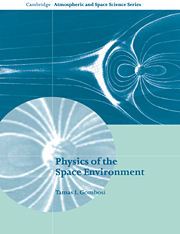Book contents
- Frontmatter
- Contents
- Preface
- Part I Theoretical Description of Gases and Plasmas
- Chapter 1 Particle Orbit Theory
- Chapter 2 Kinetic Theory
- Chapter 3 Basic Plasma Phenomena
- Chapter 4 Fluid and MHD Theory
- Chapter 5 Waves and Oscillations
- Chapter 6 Shocks and Discontinuities
- Chapter 7 Transport of Superthermal Particles
- Part II The Upper Atmosphere
- Part III Sun—Earth Connection
- Appendices
- Bibliography
- Index
Chapter 3 - Basic Plasma Phenomena
Published online by Cambridge University Press: 22 October 2009
- Frontmatter
- Contents
- Preface
- Part I Theoretical Description of Gases and Plasmas
- Chapter 1 Particle Orbit Theory
- Chapter 2 Kinetic Theory
- Chapter 3 Basic Plasma Phenomena
- Chapter 4 Fluid and MHD Theory
- Chapter 5 Waves and Oscillations
- Chapter 6 Shocks and Discontinuities
- Chapter 7 Transport of Superthermal Particles
- Part II The Upper Atmosphere
- Part III Sun—Earth Connection
- Appendices
- Bibliography
- Index
Summary
Most space plasmas are quasi-neutral statistical systems containing mobile charged particles. On the average, the potential energy of a mobile particle due to its nearest neighbor is much smaller than its kinetic energy. This definition excludes high density plasmas (such as solid states or stellar interiors), but the description of these forms of matter goes far beyond the scope of this book.
Owing to the long-range nature of electromagnetic forces, each charged particle in the plasma interacts simultaneously with a large number of other charged particles. This process results in collective behavior of the plasma particles: In some respect even a low density space plasma behaves as a continuous medium.
In gaseous, nonrelativistic plasmas the motion of individual particles is governed by electromagnetic fields, which are a combination of internally generated (due to the presence and motion of charged particles) and externally imposed fields. The motion and interaction of plasma particles can be described by nonrelativistic classical mechanics and by electrodynamics, quantum mechanical effects are usually neglected.
The interaction of charged particles with electromagnetic fields is described by the force (Eq. 1.16), whereas the electromagnetic field itself obeys Maxwell's equations (Eqs. 1.1, 1.2, 1.3, and 1.4). It should be noted that one must include the contributions of plasma particles to the charge and electric current densities.
- Type
- Chapter
- Information
- Physics of the Space Environment , pp. 53 - 60Publisher: Cambridge University PressPrint publication year: 1998



